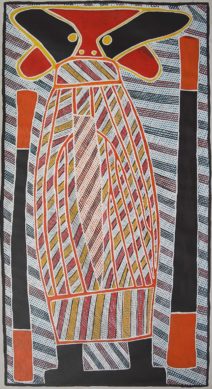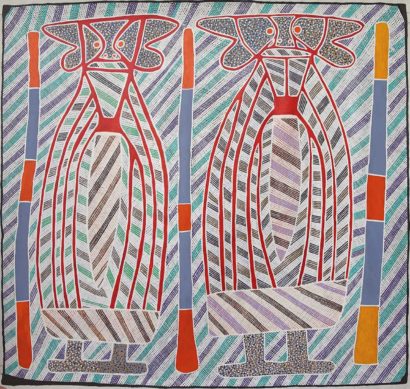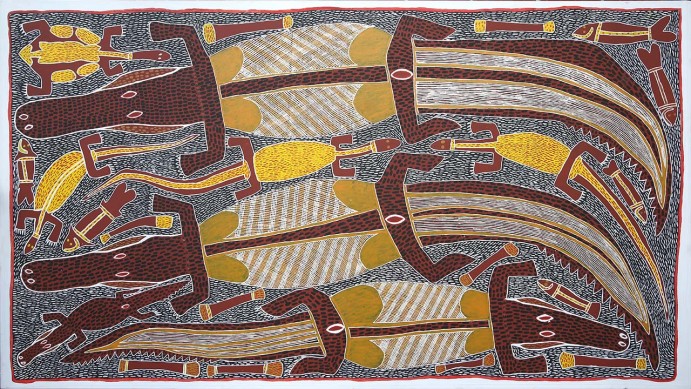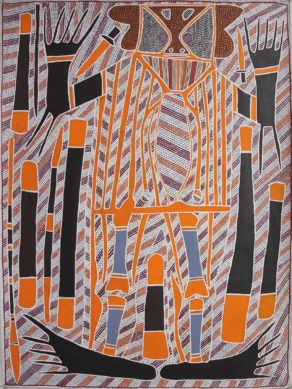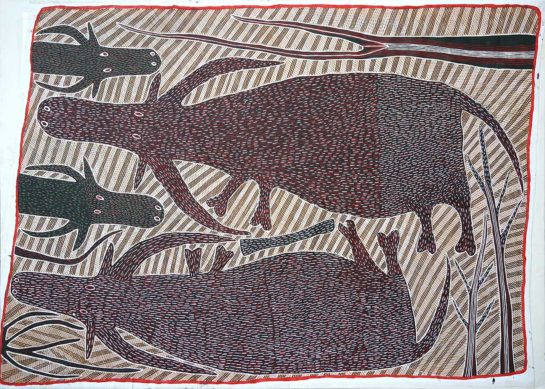Djambu Barra Barra
Djambu Barra Barra - Roper River Artist, Southern Arnhem Land, painted animal totems and ceremonial designs
Djambu Barra Barra (also recorded as Sambo Burra Burra) was born in the bush near the Roper River, and spent most of his early life at his homelands at Nillipigee in Central Arnhem Land. Djambu Barra Barra first came in from the bush in his early 20s, when his Wagilak father, Ritharrngu mother and family sought limited contact with the wider non-Aboriginal community. In the 1980s Barra Barra moved to live at Ngukurr with his wife, fellow artist Amy Jirwulurr Johnson, and their extended family.
Djambu Barra Barra began to paint in 1987 at Ngukurr community. He soon became one of the leading artists at Ngukurr, known for his daring use of the x-ray and cross-hatching bark painting styles, which he expressed in bright acrylics on canvases, sometimes on a monumental scale. His stories are of epic hunts, mortuary and circumcision Dreamings and other Men’s stories. Where Djambu Barra Barra’s paintings depict the killing and handling of large game, he reflects the traditions that must be followed under prescribed ritual procedures. As a hunter and meat provider, Djambu was as an acute observer of nature and the animals are always accurately drawn, complete with internal organs which have ritual meaning.
Arnhem Land artists generally paint their own animal ancestral beings, so that even simple images of individual animals have religious meaning. Djambu Barra Barra’s early work depicting Crocodile story was exhibited in the 4th National Aboriginal Art Award in 1987 and achieved widespread critical acclaim. In defiance of convention, the image refused to stay within the usual square format. The tail of the huge saltwater crocodile, splayed diagonally across a bright yellow ground, and broke through the edge of the picture plane. Many of Djambu Barra Barra’s paintings are vibrant and powerful with what Djambu called “big corroboree stories”.
Djambu Barra Barra held his first solo exhibition in 1991 at Gallery Gabrielle Pizzi in Melbourne, and participated regularly in Ngukurr group exhibitions from 1988. His work was exhibited in Aratjara: Art of the First Australians, Kunstsammlung Nordrhein-Westfalen, Düsseldorf, Germany in 1993; Power of the Land: Masterpieces of Aboriginal Art, National Gallery of Victoria, Melbourne, 1994; and in Ngundungunya: art for everyone, National Gallery of Victoria, Melbourne, 1997. Djambu Barra Barra’s numerous exhibitions in major galleries and his works in private collections provide an outstanding record of his artistic reputation and established identity as a senior Aboriginal artist.
Collections
- National Gallery of Australia, Canberra
- National Gallery of Victoria, Melbourne
- Museum and Art Galleries of the Northern Territory, Darwin
- Art Gallery of Western Australia, Perth
- Australian National Maritime Museum, Sydney
- Northern Territory Museum of Arts & Sciences
- The Holmes a Court Collection
- Kerry Stokes Collection
- Supreme Court, Darwin
- Artbank Sydney
Awards
1998, Winner of Telstra Open Painting Award, 15th National Aboriginal and Torres Strait Islander Art Awards, Museum and Art Gallery of the Northern Territory, Darwin
Solo Exhibitions
1991 Sambo Barra Barra, Gabrielle Pizzi, Melbourne
1994 Sambo Barra Barra, Alcaston House Gallery, Melbourne
1997 Sambo Barra Barra, Hogarth Gallery, Sydney in conjunction with Alcaston
1998 Devil Devil, Alcaston Gallery, Melbourne
Selected Group Exhibitions
1989 Group Show, Alcaston House Gallery, Melbourne
1991 Aboriginal Art and Spirituality, High Court, Canberra
1992 Group Show, National Musdeum of Modern Art, Tokyo
1992 National Aboriginal Art Award, Hogarth Gallery, Sydney in conjunction with Alcaston
1993 Aratjara, Kunstsammlung Nordrhein, Westfalen, Dusseldorf
1993 Aratjara, Hayward Gallery, London
1993 Gold Coast City Art Award, Surfers Paradise
1993 Group Show, Alcaston House Gallery, Melbourne
1994 Group Show, Gallerie Australis, Adelaide in conjunction with Alcaston
1994 Group Show, Cooee Aboriginal Art, Sydney in conjunction With Alcaston
1995 Group Show, Hogarth Gallery, Sydney in conjunction with Alcaston
1996 All about Art, Alcaston Gallery, Melbourne
1996 Gold Coast City Contrad Jupiters Art Prize, Gold Coast City Art Gallery, Qld
1997 Ngundungunya: Art for Everyone, National Gallery of Victoria
1997 Beat Strit – ten years on Galleries: Alcaston – Melbourne, Fireworks – Brisbane, Imaging the Land National Gallery of Victoria
1996 All about Art, Alcaston Gallery, Melbourne Australian Contemporary Art Fair 6, Melbourne
1999 Amy Johnson & Sambo Barra Barra, Rebecca Hossack Gallery, London
2001 Little Gems, Japingka Gallery, Fremantle
2014 Private Eye, Japingka Gallery, Fremantle

